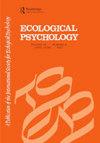婴儿对迫在眉睫的危险的大脑反应:神经连接模式的退化
IF 1.7
3区 心理学
Q3 PSYCHOLOGY, EXPERIMENTAL
引用次数: 9
摘要
大多数动物的一个基本属性是能够看到一个物体是否在直接碰撞的过程中接近,如果是,什么时候会碰撞。利用高密度的婴儿脑电图和在三种不同加速度下逼近的隐现刺激,我们先前发现了即将发生碰撞的视觉信息是如何在年轻的人类神经系统中持续的。在本研究中,我们利用25个4-5个月和12-13个月的婴儿的纵向数据,我们发现,在视网膜定位后,婴儿与隐约相关的大脑活动明确定位于视觉皮层(V1),但在其组织中具有高度适应性。通过分析电源流的方向,我们提供了高度可变性的证据,这种可变性分布在视觉皮层相对较大的区域。研究结果揭示了一个高度动态的功能组织,在试验之间,连接模式不断出现并在许多不同的方向上发生变化。这表明通过再入原理神经连接模式的退化,神经元暂时聚集在一起,以必要的精度实现适当的隐现反应。本文章由计算机程序翻译,如有差异,请以英文原文为准。
Infants’ Brain Responses to Looming Danger: Degeneracy of Neural Connectivity Patterns
Abstract A fundamental property of most animals is the ability to see whether an object is approaching on a direct collision course and, if so, when it will collide. Using high-density electroencephalography in infants and a looming stimulus approaching under three different accelerations, we previously found how visual information for impending collision is sustained in the young human nervous system. In the present study, using longitudinal data on 25 infants at 4–5 months and 12–13 months, we show that infants’ looming-related brain activity is clearly localized in the visual cortex (V1) following retinotopic mapping, but is highly adaptive in its organization otherwise. Analyzing the orientation of electrical source flow, we provide evidence for a high degree of variability, spread across a relatively large area of the visual cortex. The findings reveal a highly dynamic functional organization, with connectivity patterns constantly emerging and changing in many different directions between trials. This suggests degeneracy of neural connectivity patterns through reentry principles, where neurons temporarily assemble to enable an appropriate looming response with the necessary precision.
求助全文
通过发布文献求助,成功后即可免费获取论文全文。
去求助
来源期刊

Ecological Psychology
PSYCHOLOGY, EXPERIMENTAL-
CiteScore
3.30
自引率
10.50%
发文量
8
期刊介绍:
This unique journal publishes original articles that contribute to the understanding of psychological and behavioral processes as they occur within the ecological constraints of animal-environment systems. It focuses on problems of perception, action, cognition, communication, learning, development, and evolution in all species, to the extent that those problems derive from a consideration of whole animal-environment systems, rather than animals or their environments in isolation from each other. Significant contributions may come from such diverse fields as human experimental psychology, developmental/social psychology, animal behavior, human factors, fine arts, communication, computer science, philosophy, physical education and therapy, speech and hearing, and vision research.
 求助内容:
求助内容: 应助结果提醒方式:
应助结果提醒方式:


